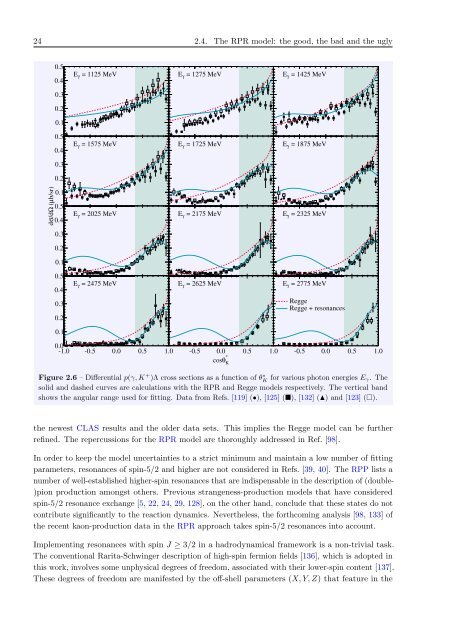Download Thesis in Pdf Format - Theoretical Nuclear Physics and ...
Download Thesis in Pdf Format - Theoretical Nuclear Physics and ...
Download Thesis in Pdf Format - Theoretical Nuclear Physics and ...
Create successful ePaper yourself
Turn your PDF publications into a flip-book with our unique Google optimized e-Paper software.
24 2.4. The RPR model: the good, the bad <strong>and</strong> the ugly0.50.4E γ= 1125 MeV0.50.4E γ= 1275 MeV0.50.4E γ= 1425 MeV0.30.30.30.20.20.20.10.10.10.50.51.0 0.5 0.0 0.5 1.0E γ = 1575 MeV0.40.4E γ0.50.5 0.0 0.5 1.0= 1725 MeV0.4E γ0.5 0.0 0.5 1.0= 1875 MeV0.30.20.30.20.30.2dσ/dΩ (µb/sr)0.10.10.50.51.0 0.5 0.0 0.5 1.0E γ = 2025 MeV0.40.4E γ0.10.50.5 0.0 0.5 1.0= 2175 MeV0.4E γ0.5 0.0 0.5 1.0= 2325 MeV0.30.20.10.30.20.10.30.20.10.50.51.0 0.5 0.0 0.5 1.0E γ = 2475 MeV0.40.40.30.30.20.2E γ0.50.5 0.0 0.5 1.0= 2625 MeV0.40.30.2E γ0.5 0.0 0.5 1.0= 2775 MeVReggeRegge + resonances0.10.10.10.00.01.0 0.5 0.0 0.5 1.00.5 0.0 0.50.01.0*cosθ K0.5 0.0 0.5 1.0Figure 2.6 – Differential p(γ, K + )Λ cross sections as a function of θ ∗ K for various photon energies E γ. Thesolid <strong>and</strong> dashed curves are calculations with the RPR <strong>and</strong> Regge models respectively. The vertical b<strong>and</strong>shows the angular range used for fitt<strong>in</strong>g. Data from Refs. [119] (•), [125] (), [132] () <strong>and</strong> [123] (□).the newest CLAS results <strong>and</strong> the older data sets. This implies the Regge model can be furtherref<strong>in</strong>ed. The repercussions for the RPR model are thoroughly addressed <strong>in</strong> Ref. [98].In order to keep the model uncerta<strong>in</strong>ties to a strict m<strong>in</strong>imum <strong>and</strong> ma<strong>in</strong>ta<strong>in</strong> a low number of fitt<strong>in</strong>gparameters, resonances of sp<strong>in</strong>-5/2 <strong>and</strong> higher are not considered <strong>in</strong> Refs. [39, 40]. The RPP lists anumber of well-established higher-sp<strong>in</strong> resonances that are <strong>in</strong>dispensable <strong>in</strong> the description of (double-)pion production amongst others. Previous strangeness-production models that have consideredsp<strong>in</strong>-5/2 resonance exchange [5, 22, 24, 29, 128], on the other h<strong>and</strong>, conclude that these states do notcontribute significantly to the reaction dynamics. Nevertheless, the forthcom<strong>in</strong>g analysis [98, 133] ofthe recent kaon-production data <strong>in</strong> the RPR approach takes sp<strong>in</strong>-5/2 resonances <strong>in</strong>to account.Implement<strong>in</strong>g resonances with sp<strong>in</strong> J ≥ 3/2 <strong>in</strong> a hadrodynamical framework is a non-trivial task.The conventional Rarita-Schw<strong>in</strong>ger description of high-sp<strong>in</strong> fermion fields [136], which is adopted <strong>in</strong>this work, <strong>in</strong>volves some unphysical degrees of freedom, associated with their lower-sp<strong>in</strong> content [137].These degrees of freedom are manifested by the off-shell parameters (X, Y, Z) that feature <strong>in</strong> the















